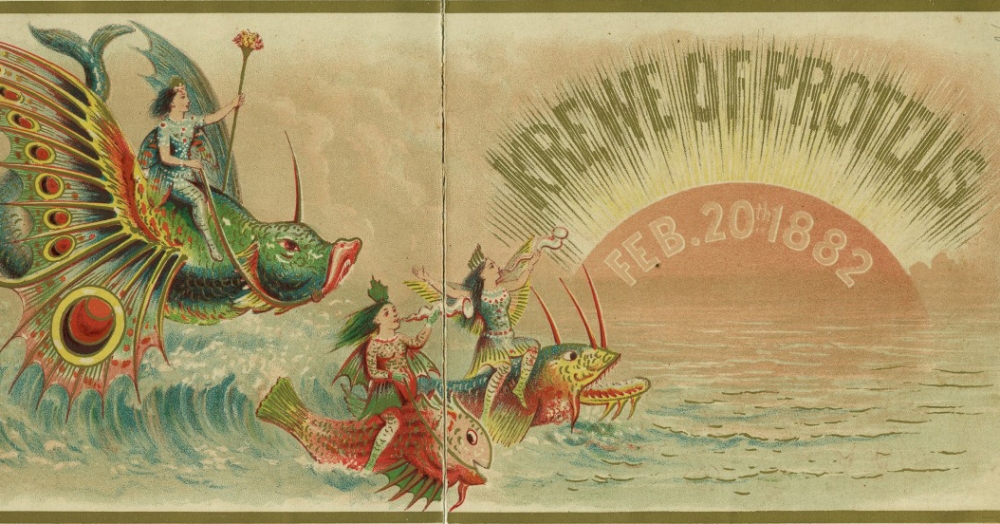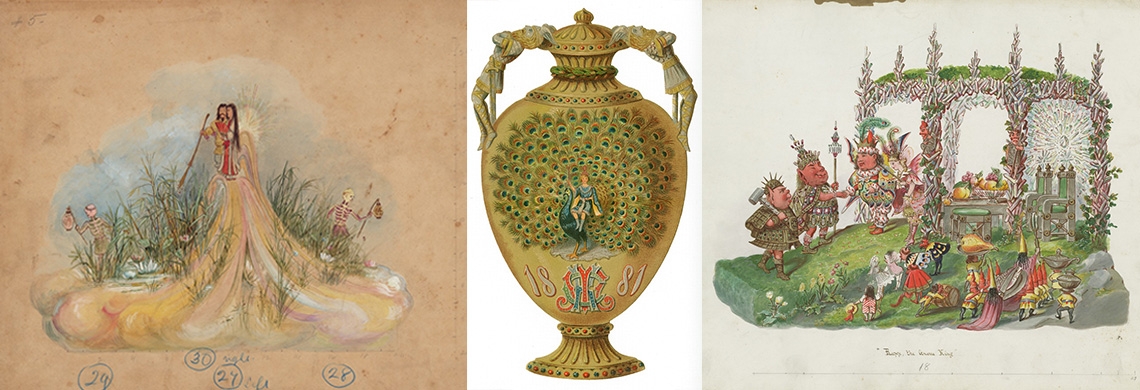Mardi Gras as we know it began in New Orleans in the second half of the 19th century, when groups of white men gathered together to form krewes and put on public parades followed by private balls, with each organization tailoring its celebration to a theme. The topics could be satirical, historical, fantastical, and exotic, and were often influenced by the popular literature and prevailing decorative movements of their day.
Themes that parade-goers might have easily recognized in the 1880s are often incomprehensible today, but careful analysis of politics, trends, and current events gives us insights into the krewes' choices. After all, ephemeral design, such as Mardi Gras floats, often reveals the deeper values, beliefs, and influences of the society that made them.
The invitations, costumes, and float designs from the first few decades of New Orleans Mardi Gras krewes, often called “the Golden Age of Carnival,” are no exception. They are stunningly beautiful, but can also be downright weird. Here are five odd, unusual, or unknown stories depicted in the early years of Carnival and how they relate to what was happening in the outside world.
1. Rapp the Gnome King and the carnage of Manifest Destiny
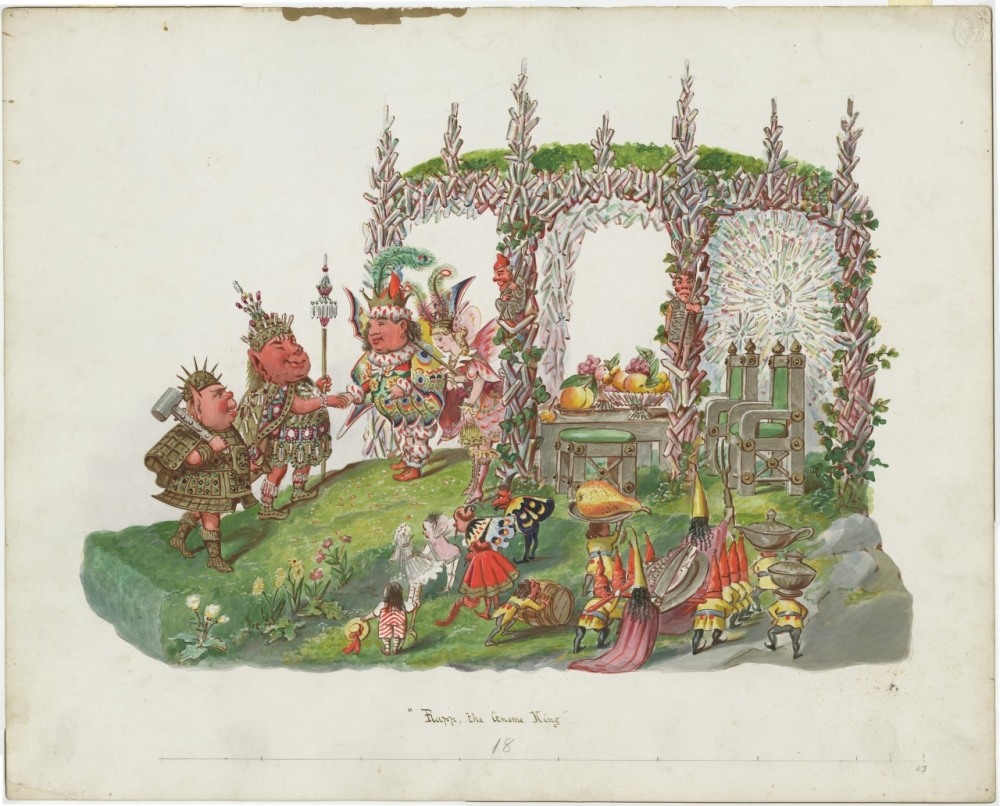
Rapp the Gnome King entertained by the elves of the Catskills, before imparting magical gifts on the last Native American girl. (THNOC, The L. Kemper and Leila Moore Williams Founders Collection, 1958.11.17)
The story:
“Rapp the Gnome King” was first published in the book The Catskill Fairies, by Virginia W. Johnson, in 1876. As the story goes, a 17th-century Native American girl is gifted objects with magical powers from Rapp the Gnome King, whom she meets after waking from a nap in the Catskill Mountains of New York. When she returns home, 200 years have passed, and her community has vanished, replaced by the railroads, steamboats, and factories of 1870s America. She then sets out on a westward journey across the continent to find her people and eventually stumbles upon their burnt village in the Rocky Mountains. She brings the one living baby to a white ranching family and is subsequently killed when a sportsman mistakes her for a bird. In the end, her body disappears to join the Gnome King.
The Parade:
This bleak American fairy tale was depicted in a float design for the 1878 Knights of Momus parade, titled “The Realms of Fancy.” While other Momus floats that year depicted more familiar fairy tales, this one stands out in its oddity. The “Rapp” float only illustrated the first scene of the modern fairy tale, not the more complex tale of Native American extinction. Three other stories from The Catskill Fairies were illustrated in the Momus parade: the “Fairy Regatta,” the “Summer and Winter Fairies,” and the “Fairy of the Cascade.”
The Context:
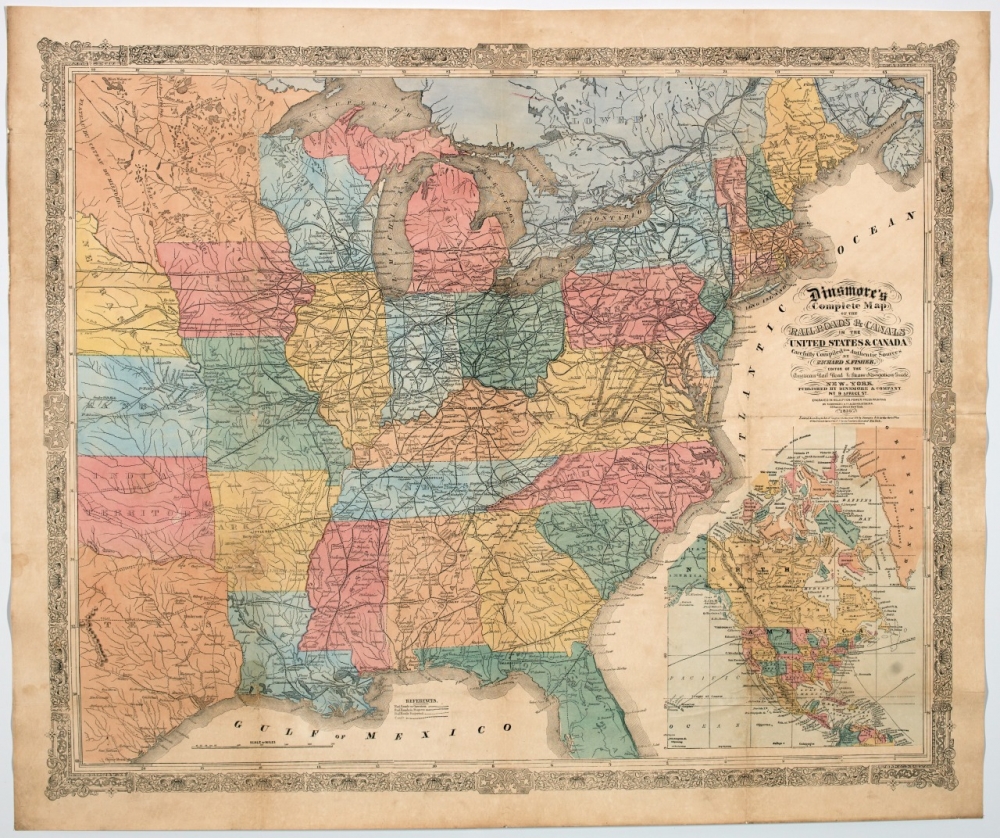
Dinsmore’s Complete Map of the Railroads and Canals in the United States and Canada, showing the westward expansion of trade in North America, was completed in 1856. (THNOC, 2014.0227)
By modern standards, this story is a jarringly unapologetic allegory of Native American expulsion in the name of Manifest Destiny, the belief that the US (specifically the white population) was destined to expand across the entire continent of North America. By the 1870s, it seemed that this destiny was almost fulfilled. The transcontinental railroad was completed in 1869, Colorado was admitted as the 38th state in 1876, and the US Army was battling the Plains Indians to take their lands. Rapp the Gnome King, ruler of the mountains and all they contained, represented the mineral wealth of the United States, reflecting the California gold rush in 1849 and the discovery of the Comstock Lode of silver in Nevada in 1859. The plight of the indigenous girl was an illustration of how American progress would tame the wild expanse of the North American continent.
2. Olaf the Peacock, a smartly dressed southerner among fallen Northern gods
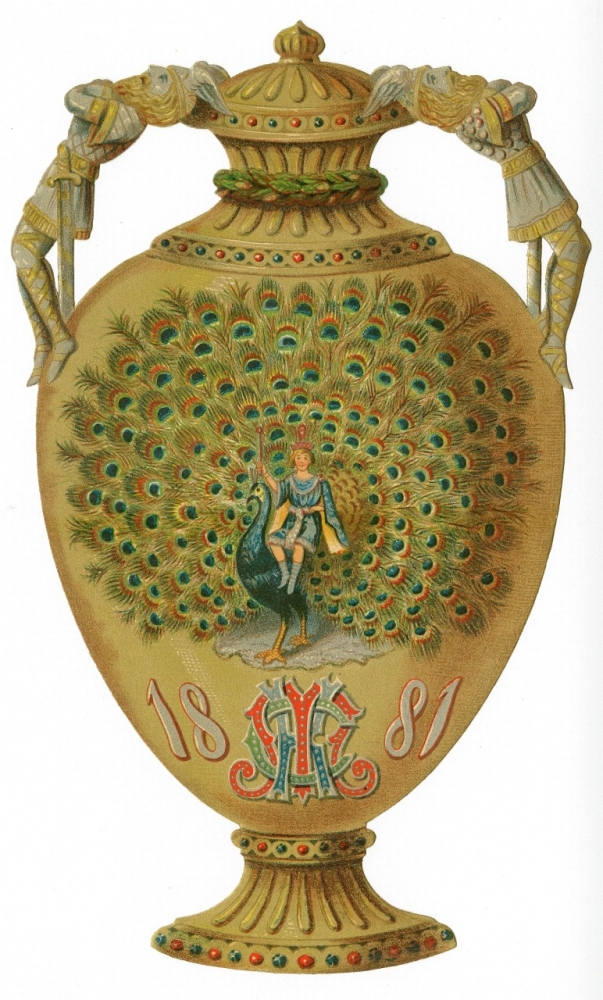
Comus as Olaf the Peacock, enthroned on his namesake bird. (THNOC, The L. Kemper and Leila Moore Williams Founders Collection, 1960.14.10)
The story:
The son of a chieftain and an Irish princess, Olaf was a leader—in legend and in real life—in Iceland during the 11th century. The nickname “Peacock” is a nod to Olaf’s taste in fine clothing. His well-dressed adventures in trade and diplomacy live on in a series of Icelandic and Scandinavian tales.
The Parade:
In the 1881 Comus presentation “Myths of the Northland,” Comus (the king of the parade) himself embodies Olaf, the sophisticated merchant, appearing perched on a giant peacock on the first float of the parade. After the king’s float, the rest of the parade depicted the Viking legend of Sigurd the Volsung and the Fall of the Niblungs. The parade was based on a translation of the Viking epic published in 1876 by William Morris, a leader of the English Arts and Crafts Movement.
The Context:
The parade was designed by Charles Briton, the godfather of early Carnival design. From 1870 until his death in 1884, Briton designed the floats and costumes for Comus, Twelfth Night Revelers, Momus, Rex, and Proteus. Born in Sweden and raised in Scandinavia, Briton knew the stories of Sigurd, the Niblungs, Valhalla, and Ragnarok well. In fact, presenting Comus as Olaf was Briton’s addition to the parade, as the Peacock character does not appear in Morris’s translated epic.
Comus’s “Myths of the Northland” and the fall of the Northern gods could be seen as a subversive dig against the northern states in post-Reconstruction New Orleans. Many early parades were more overt in their satire, such as Comus’s “Missing Links in Darwin’s Origin of Species” and the Twelfth Night Revelers’ “The World of Audubon,” both designed by Charles Briton in 1873. The Darwinian parade depicted carpetbaggers and Republican politicians as creatures along the evolutionary ladder. Notorious General “Spoons” Butler was a scavenging Hyena, while President Ulysses S. Grant embodied an unevolved tobacco grub.
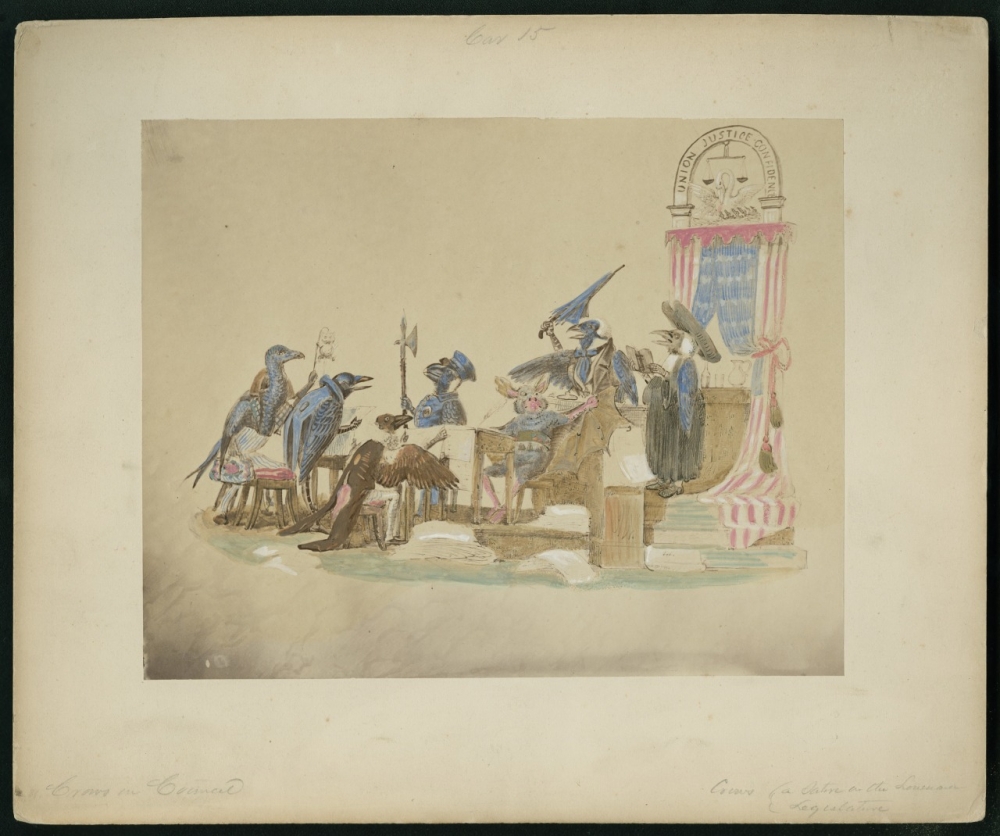
The “Crows in Council” float design from the Twelfth Night Revelers’ 1873 parade depicts black legislators of Reconstruction Louisiana as cackling birds. (THNOC, 2015.0026.15)
In “The World of Audubon,” Louisiana politicians were turned into the birds of the bayou. On one float, cackling black birds under the state seal represented the African American lawmakers of the Reconstruction-era Louisiana legislature. The “Myths of the Northland” may not have been as overt as the beastly themes, but for those in the know, Olaf, the well-dressed Southerner (Ireland is as south as one can get in the North Sea), was making the statement that the South could rise again.
3. Proteus and the city on the banks of the "New World's Nile"
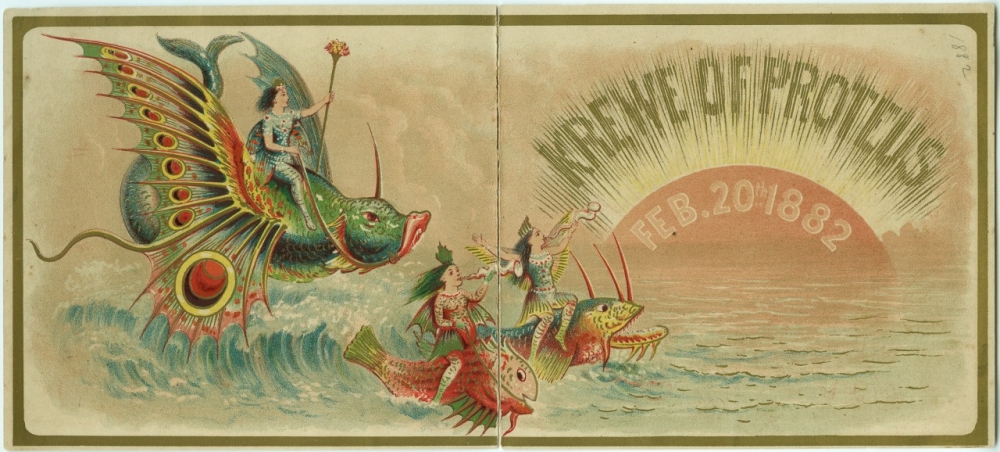
The sea god Proteus is shown reawakening at the mouth of “The New World’s Nile” (a.k.a. the Mississippi River). (THNOC, The L. Kemper and Leila Moore Williams Founders Collection, 1960.14.46)
The story:
Proteus, the mythic “Old Man of the Sea,” was a soothsayer and shape-shifter of Greek mythology. The eldest son of Poseidon, Proteus was the herdsman of seals and sea monsters and lived on the island of Pharos off the coast of Egypt. Proteus could foresee the future but disliked sharing what he knew. Those who wished to hear his prophesy had to capture him while he slept on the beach and hold him tight while the god transformed into many different animals until he tired and relented.
The Parade:
The Krewe of Proteus included the story of their namesake in their first presentation in 1882. The theme that year was “Ancient Egyptian Theology,” a nod to Proteus’s home at the mouth of the Nile. The god appeared in the second float of the parade—the King’s float—mounted upon an enormous, sparkling dolphin and preceded by sea nymphs astride sea monsters.
The Context:
The brand-new krewe claimed that the prophetic, transmutable sea god had reawakened and found a new home in New Orleans, “the great city on the banks of the New World’s Nile.” This unusual metaphor, equating the Mississippi River with the Nile, places New Orleans at the center of civilization. The god Proteus’s appearance in the Mississippi Delta, rather than the Nile, metaphorically extended the legacy of New Orleans culture back to the classical era. Adding Proteus to the pantheon of Mardi Gras gods was an acknowledgment of the importance of water to the survival (or destruction) of the city, and his shape-shifting nature was perfect for the constantly changing costumes and themes of Carnival.
4. Izanagi and Izanami, first parents of Japan, and the Aesthetic Movement
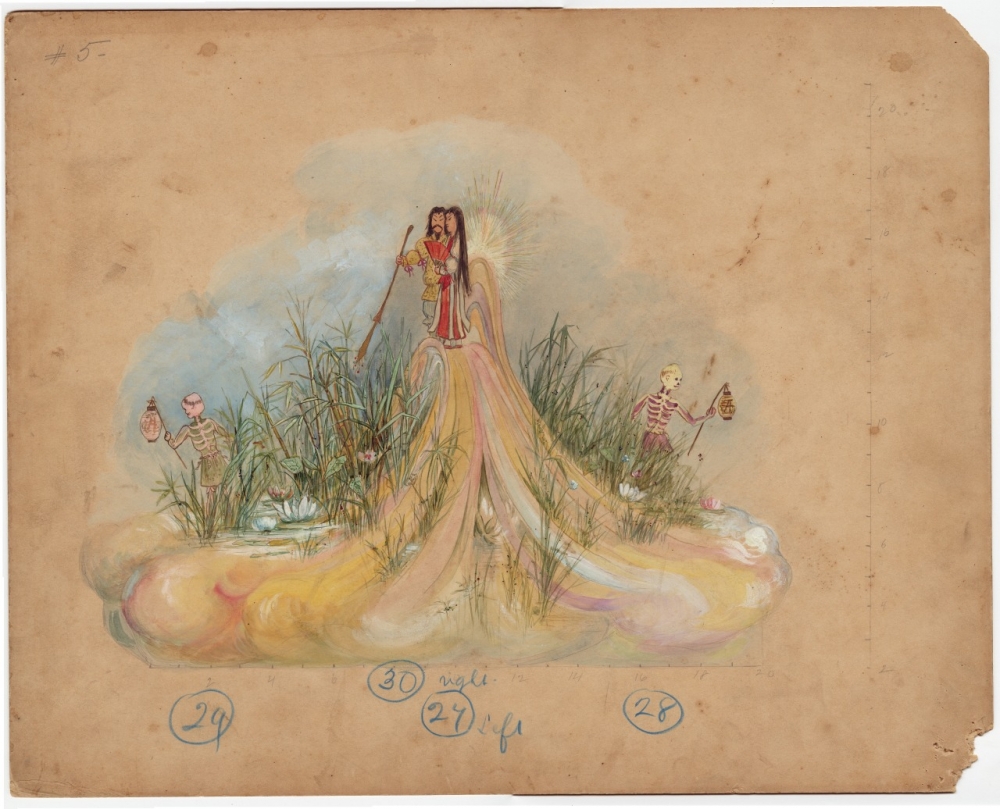
This 1892 float design depicts Izanagi and Izanami, the central figures of the Japanese creation myth. (THNOC, 1986.187.3)
The story:
Izanagi and Izanami are the central figures of the Japanese creation myth. Their many children became the islands and deities of Japan. Unfortunately, Izanami died of burns after giving birth to the fire god. Izanagi sought to retrieve her from the underworld, but having already eaten the food there, she could not leave. Izanagi had promised not to look at his deceased wife in the underworld, but he could not resist. He lights a fire only to see Izanami’s decaying body. To avenge her shame, Izanami and other female demons chased her husband from the underworld.
The Parade:
Izanagi and Izanami stood on top of the rainbow bridge between heaven and earth, with skeletons of the underworld below them, in the 1892 Comus parade, “Nippon, the Land of the Rising Sun.” The parade was the second design of Jennie Wilde, a graduate of the Art Students League of New York and the Southern Art Union. Wilde embraced the Aesthetic movement and art nouveau style of the late 19th century, and this parade, with its beautiful Japanese design, embodies the Orientalism of the time.
The Context:
The US had been trading with China since the end of the American Revolution, but a new treaty in 1844 had solidified American trading rights with the Qing Empire. Following the Meiji Restoration in 1868, Japan ended over two centuries of isolation and opened its ports to trade from the West. This increase in trade from both countries sparked a fascination with collecting Japanese and Chinese art in Europe and the US. Western artists drew inspiration from Japanese prints, and designers of decorative arts began copying the lines and motifs of the Far East. These Asian influences were a major part of the Aesthetic movement of the 1870s and ’80s.
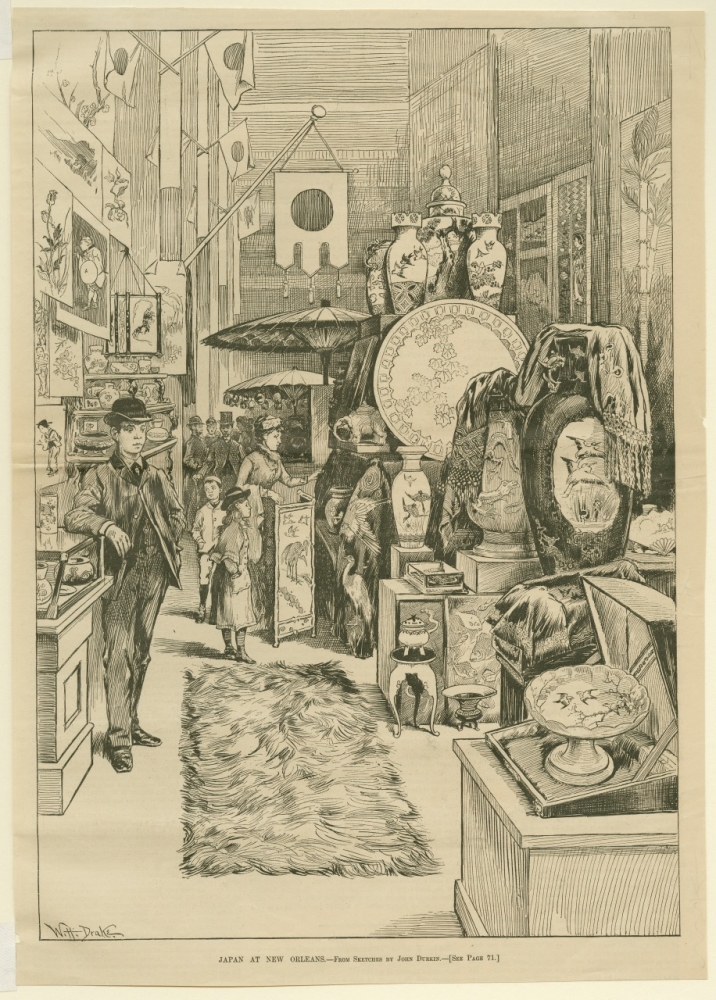
An etching shows the Japanese exhibition at the Cotton Centennial Exhibition in New Orleans in 1884–85. (THNOC, 1974.25.2.196)
In New Orleans, the Japanese exhibition at the Cotton Centennial Exhibition in 1884–85 provided new inspiration for designers. Further connection between the two locales came in 1890, when Lafcadio Hearn, a journalist and author of popular books on New Orleans culture, moved to Japan, sending reports of his new life with the Japanese.
5. Proteus 1893, “Kalevala” and the Viking Revival
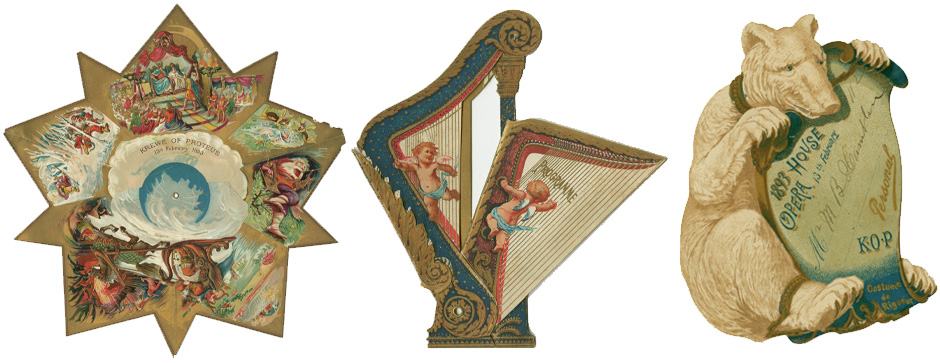
A Proteus 1893 invitation, admit card, and dance card were all inspired by the epic of Kalevala. (THNOC, The L. Kemper and Leila Moore Williams Founders Collection, 1958.102.45 and 47; 1961.48.28)
The story:
The epic of Kalevala, a founding legend of present-day Finland, tells a magical story of creation, romance, and combat in the cold North. The epic follows three male heroes who battle Louhi, the Mistress of the North, for a magical staff called the Sampo, which is destroyed in the fight. Enraged by the loss, Louhi sends diseases and polar bears to kill all the people and cattle of Kalevala and removes the sun and moon from the sky. Väinämöinen—the first man in Kalevala and a skilled harpist and singer—helps restore the sun and moon. He then sails away, leaving only his songs as his legacy.
The Parade:
This story was largely unfamiliar to the New Orleans audience when the Krewe of Proteus presented “Kalevala: Myths of Finland” as their theme in 1893. Kalevala, an epic poem of Finnish folklore, was first published by Elias Lönnrot in 1835 and was fully translated into English five years before the parade in 1888. Floats dripped with icicles, the invitation depicted the drama of the battles over the Sampo, the admit card was illustrated with the polar bears sent to destroy Kalevala, and the dance card was a pivoting harp of Väinämöinen.
Although Charles Briton and Bror Anders Wikstrom, the first carnival designers, were both from Scandinavia, this theme of the far north was designed by Carlotta Bonnecaze, a native New Orleanian from a prominent Creole family. Little is known about her background, but she was the sole designer for the Krewe of Proteus from 1885 to 1897.
The Context:
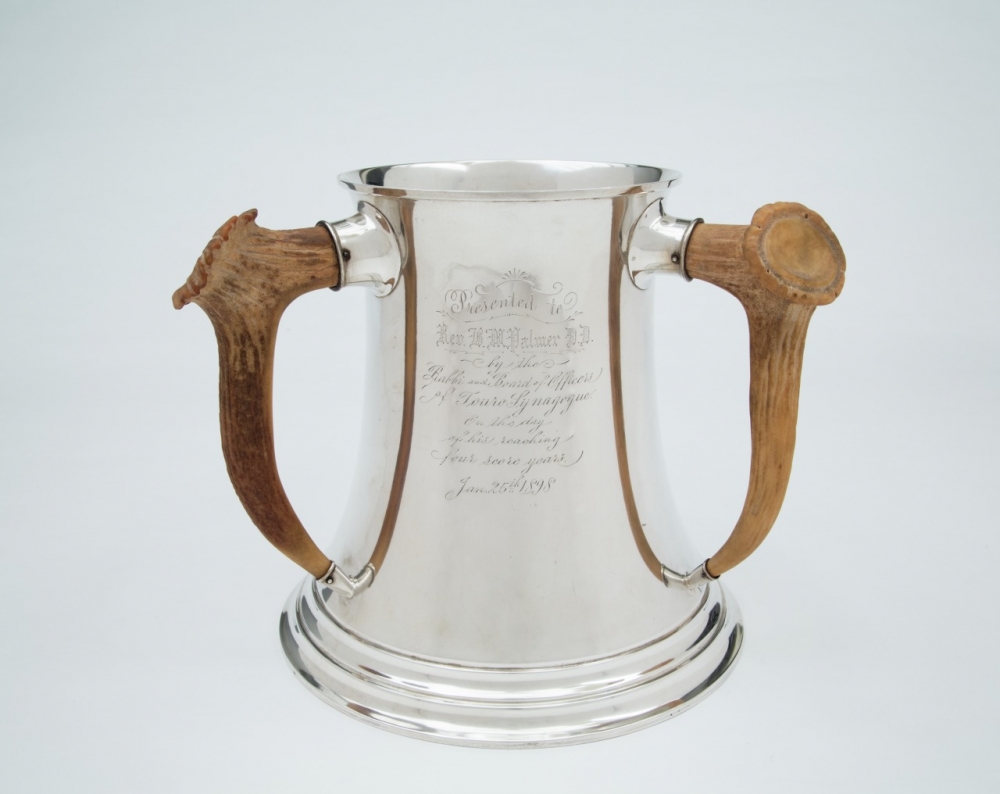
Horn handles like the ones affixed to this tyg were all the rage in the brief style moment of the Viking Revival. (THNOC, 2016.0169.8)
Although the tale was fairly new to the literary scene, the Finnish epic fit into a brief style moment of the late 19th century: the Viking Revival. Icebergs, horns, and bearded men in furs were all the rage in decorative arts of the time. New translations of folklore, such as William Morris’s The Story of Sigurd the Volsung, the English translation of the Kalevala, and other Norse epics, provided poetic inspiration for the style. Technically, the Kalevala is not about Vikings, and Finland is not part of Scandinavia. But to New Orleanians at the end of the 19th century, this theme fit right into the style of the moment.
Learn more about the history of Mardi Gras on our special “Rites, Ritual, and Revelry” tour detailing the history of Carnival celebrations in New Orleans. Tours are available Tuesday–Sunday at 11 a.m. through Friday, February 21. Admission is $5 per person (free for members).
